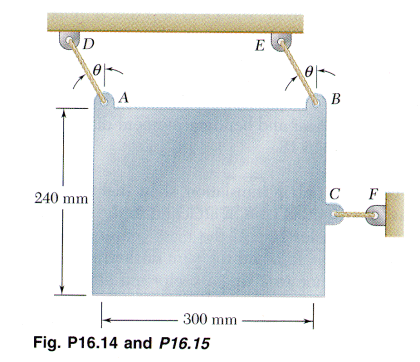
16.15 (Curvilinear Translation)
A uniform rectangular plate has a mass of 5 kg and is held in position by three ropes as shown. Determine the largest value of q for which both ropes AD and BE remain taut immediately after rope CF has been cut. (What this is really asking is this: At q = 0, TA = TB. But as q increases, there will be some angle q that one of the ropes' tension will go to zero.)

Comments/Hints:
1. This is a curvilinear translation problem, like Sample Problem
16.2. When cable CF is cut, the plate will move in a circular arc
because of the two parallel equal length constraints of cables AD and BE.
But the plate will remain horizontal. In other words, the top edge AB of
the plate will remain parallel to the ceiling DE. Thus, the plate itself
has no angular rotation; it's translating, though moving along an arc.
2. Draw a Free Body Diagram (FBD) showing all forces and a Kinetic Diagram
(KD) showing ma terms located at the mass center, G, at the center of the
plate. (Since the plate has just been released from rest, the man
= mv2/r term is zero, so the only term is the mat term.)
3. Sum forces = ma in the tangential direction, sum forces = ma in the
normal direction, and write a moment equation about the center of gravity, G.
4. Try some angles and see what you get. Answers at different
angles: At q = 0, TA = TB);
and at q = 30 degrees, TB = .3681TA.
From this we see that TB is going to zero.
5. Set TB = 0 and solve for the angle at which this
occurs. You should get q = 51.3 degrees.